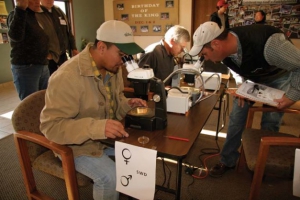Grape growers learn to identify spotted wing drosophila at a Washington State Grape Society meeting.
Preliminary tests conducted last fall indicate that Washington State grapes might not be attractive to the spotted wing drosophila, an invasive new pest that has popped up across much of U.S. agriculture in the last few years.
Drosophila suzukii, also called spotted wing drosophila, was first identified by Japanese scientists in 1939. Though the tiny fruit fly has spent the last 30 years thriving in Hawaii, it was first detected in California in 2008 in raspberries and subsequently found in Oregon and western Washington in 2009.
When Dr. Doug Walsh, Washington State University entomologist, first heard of its debut in the state, he admits that he “kind of pushed the panic button” because cherries and Concord grapes were described in Japanese research literature as being the two most impacted crops in Japan. Adding to his fears were reports from Medford, Oregon, that spotted wing drosophila was found in Pinot Noir grapes.
Initially, WSU entomologists thought that eastern Washington crops might not be greatly impacted. A Canadian-developed predictive model based on temperature and humidity showed eastern Washington to be considered marginal in terms of spotted wing drosophila survival because of its hot, dry climate. However, high numbers of the pest were caught in a variety of traps placed in eastern Washington tree fruit last summer and fall.
Walsh began trapping for the tiny fruit fly in grapes and tree fruit in the Yakima Valley, putting out traps in vineyards and orchards in late February. At the same time, WSU’s Dr. Betsy Beers began trapping in north central Washington. Until July, trap catches for the spotted wing drosophila were blank, though low numbers of other drosophila species were being caught, he said. The first detection was in a Mattawa cherry orchard in July. “After that, there was an explosion of flies caught in traps, and the pest was found everywhere.”
Spotted wing drosophila was still being caught in traps into November, he reported, adding that pressure from the pest, based on trap catches, was less in Yakima Valley than in the Wenatchee area. By the end of trapping in 2010, results from the grape trapping showed that out of 1,550 samples, less than one fly per trap was caught, on average, during the season—a number substantially less than the catches in other tree fruit.
Grape no-choice tests
Walsh initiated “no-choice” field and lab tests beginning in September to learn when wine and juice grapes may be ripe enough to attract spotted wing drosophila.
In the field tests, conducted weekly, whole Syrah clusters were covered with sleeve cages with 30 adult flies enclosed, providing the flies with no alternative food source. After one week, the clusters were brought into the lab to look for maggots or adult flies.
“In working with Syrah, we never got successful colonization in the field on clusters until October 7, and that was about a week to ten days after the grapes would have been commercially harvested,” he said.
For the lab no-choice tests, Concord, Riesling, and Merlot grapes were collected from Washington vineyards that had not been treated with insecticides. Organic Flame seedless grapes were purchased from the local grocery store to serve as the control. Wounded and nonwounded grapes were put into small cups with five female SWD adults added. To simulate wounds, grapes were pricked to mimic a bird peck. Samples were monitored to learn if eggs were laid and developed into larvae, adults, and pupae. Tests were run every other week from September into October.
Walsh reported that for the most part, the females did not lay eggs in unwounded Washington grapes. “But if we provided the female with an injury site by puncturing the skin, we did get successful ovipositioning. The skins on our Washington grapes are pretty tough, and it would seem that the females are not easily capable of laying eggs in Washington grapes, for the most part.”
The researchers also found that survivorship of immature spotted wing drosophila was substantially less in Washington grapes than in the store-bought California Flame seedless table grapes. “There’s something about our Washington grapes—maybe the lower pH or higher acidity—that makes them not as good a host as the table grapes,” he said. “The flies really do need an injury site in grapes,” Walsh pointed out, adding that in Riesling, even though eggs were laid in the injured samples, they failed to develop and emerge as adults. By comparison, California scientists counted more than 50 adult flies emerging from an individual Bing cherry.
While Washington juice and wine grapes may not be as attractive to the new fruit fly as other crops, Walsh said there are potential quality issues for both types of grapes. “Drosophila flies are known to harbor yeasts and other bacterial rots. With any fruit injuries, there is potential to introduce these yeasts and rots into the fruit. That would also be a concern for juice grapes.”
Researchers from WSU, Oregon State University, and the University of California have teamed up to learn more about the destructive pest and are sharing a $5.8-million grant from the Specialty Crop Research Initiative, administered by the U.S. Department of Agriculture. Research is focusing on phenology, trapping and monitoring, pesticide efficacy, and fruit susceptibility.
Walsh provided his spotted wing drosophila update during statewide grape talks in November.


Leave A Comment